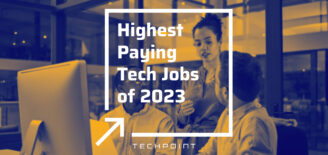Can Indy’s tech industry set an example for women and access to child care?
Would you be more likely to say yes to a career in tech if the company recognized the need and offered options for child care?
It’s an issue that women have raised since we’ve had babies, and one Indianapolis entrepreneur and mother is speaking up with bold ideas for change. “If women don’t have access to basic services, they don’t have a seat at the table,” says Jillian Walker.
Jillian is no stranger to advocating for her community. You may know her from her work as Director of Operations with Open for Service, a nonprofit that spun out as a response to RFRA, or her work at High Alpha, a venture capital and tech portfolio studio in Indianapolis.
“As a woman in tech, I heard from moms who said ‘I want to have a kid, but I don’t think I can do it right now.’ Even just the thought of having a child meant we had to get on every daycare waiting list. It became too much, and I wanted to help,” says Jillian.
Indianapolis’ emerging tech ecosystem is on the brink of a potential win for Amazon’s second headquarters. Salesforce has expanded their operations with apprentice programs, and Infosys is reaching their goal of adding 3,000 jobs to Indy’s workforce. The question is whether Indy can keep up with these three things: the incoming demand for child care, quality and creative child care options that fit the needs of tech workers, and an ethos that respects and supports women and families who want to have children.
For those reasons and more, Jillian and her co-founder Eric Tobias are launching The Microchip Academy, a child-centered children’s academy for infants and kids through the age of five that will serve Indy’s tech and downtown community. Both are currently pursuing a curriculum, educators, and a location of roughly 20,000 square feet near Mile Square with grand goals of opening up access for more families who live or work downtown, but especially those in the tech community.
The demand
It’s no secret that today’s childcare options are few and far between and include long waiting lists.
“Waiting lists are not something to boast about. If you rely on a lack of other childcare to keep your business afloat, you let the demand outweigh the quality of care,” says Jillian. “A two-year waiting list for you might look nice on paper, but it doesn’t help the kids.”
Brittany Luebke of tech company ReturnPath knows the waiting list experience all too well. “When pregnant with my daughter, I told our daycare the week after I found out I was pregnant, as my son was currently in daycare there. I was put on the wait list but still would have had to figure something out for about three months after returning to work for her. So in total, there was about a year wait.”
And if the waiting list itself isn’t enough to worry new parents, the location is doubly challenging. “In my experience, I didn’t find many daycare options near downtown. The couple that was available had a long waiting list, but I was given advice early on to sign up as soon as possible,” says Kristen Hamerstadt of SmarterHQ. “If you live or work near downtown there are not as many flexible options in finding people through your network who are willing to watch children in their own homes for a cheaper price than daycare, whether it’s a stay at home mom or someone who is retired. Many of those options tend to live in the suburbs”
Quality, creative child care options
While The Microchip Academy has high goals for multiple locations, adding one more childcare facility isn’t going to solve the whole demand issue. Jillian acknowledges that The Microchip Academy will likely have waiting lists. The difference between her childcare option and others is in the quality of care. “I don’t want to be full because there’s nothing else. I want to be full because we are the best.”
Those who work in the fast-paced and ever-changing world of tech are starting to demand innovation in childcare. “Tech workers push the boundaries for themselves and their children and look to something other than the status quo,” says Jillian. “Most childcare centers are focused on rating and curriculum standards which is great, but we can do more than a baseline. We want to push what education and play look like for our kids.”
For The Microchip Academy, that means the curriculum will be child-centered and inclusive. “Child-centered isn’t a free for all. It’s child led. Kids will have the opportunity to experiment with various subjects and then dive deeper into what they are interested in. It’s contextual learning.” Jillian shares that The Microchip Academy will focus on STEAM (science, technology, engineering, arts, and mathematics) and will enhance learning and play through technology when appropriate. She also plans to bring on environmental education teachers and include nature exploration as a core component of the center and bring an intentional focus on serving kids with special needs.
But it’s not just about the kids. Parents could participate in a monthly speaker series and talk about things moms and dads need to talk about. “Most of the people I hang out with are parents of my son’s friends. Think about the community we already have in tech, and how those people come together to network and learn from each other. Now imagine that’s happening because of where your kids go for childcare. We can build the tech ecosystem from a grassroots level,” says Jillian.
Access to basic services
Tech companies are known for creative cultures and flexible work environments. Yet there’s a difference between what employee benefits are most important to a single 22-year-old or a married 29-year-old with children under the age of five.
Regardless of whether you think businesses or government should subsidize child care, we all realize that childcare is something parents must have access to, even if they pay for it themselves. “Tech recruiters have got to get that this matters. If we do not create services for these people to stay in the workforce, they are going to leave, which is what they are doing. Nobody wins,” says Jillian.
Some tech companies lead by example. Since March 2017, Salesforce has enacted a policy that offers primary caregivers 26 weeks, or roughly 6.5 months, of paid time off for caregiving and bonding with a new baby or adopted child. These benefits aren’t yet pervasive in Indy’s tech ecosystem, and company culture is all too often relegated to what is better known as amenities, not benefits. “We all can have kombucha on tap and ping pong tables, but if you tell me you are going to give me subsidized child care, I will pick that over a ping-pong table culture,” says Jillian.
The Microchip Academy has an additional goal in mind for increasing access to basic services for women of all backgrounds. “We made a promise to Deputy Mayor of Economic Development, Angela Smith Jones, that we would hold 10 percent of spots in our center for free tuition specifically for kids who represent gender or racial diversity,” says Jillian. “We have to acknowledge that the tech industry is mainly white and middle class. How do we intentionally teach tolerance, empathy, and acceptance? We have to be aware of where we are.”
Ready to build
Jillian and Eric are focused on building The Microchip Academy up so it is operational by mid-2019. They are reviewing locations that are central for great downtown access, with pick up and drop off ability, and first-floor care that meets the compliance needs for infants. While there might seem like an ample amount of space in downtown Indianapolis that would be perfect for this academy, they have run into a few challenges due to the strict compliance and regulation needs for child care facilities. However, both are confident they will find the right spot.
“If Indy wants to be a strong tech hub that attracts talent from other states and retains talent here, then our community needs to get serious about access to child care,” says Jillian. “We can’t be a world class city without it.”
For more information about The Microchip Academy, contact Jillian at info@microchipacademy.com.








































